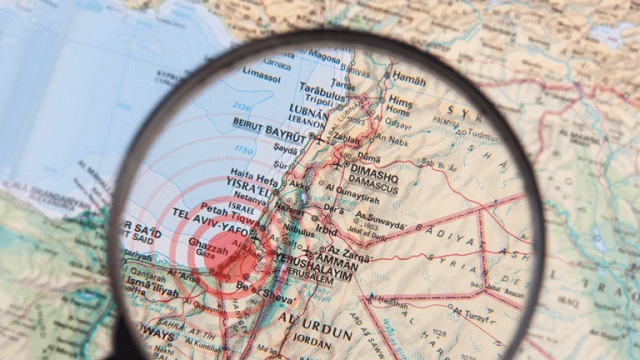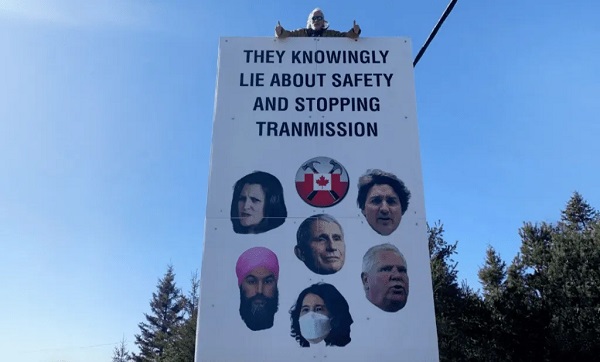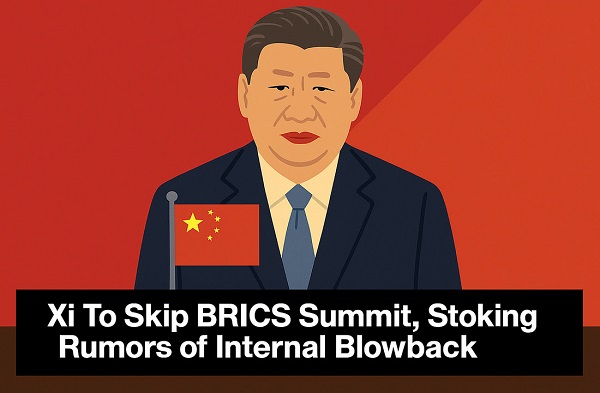Brownstone Institute
Make no mistake, the Israel-Hamas conflict is Canada’s fight too

By Joe Adam George
The threats posed by the ‘new axis of evil’ comprising Russia, China and Iran have now mushroomed into two major conflicts
On October 7, Canadians woke up to images of grisly war crimes committed by Hamas, a listed terrorist entity in Canada, halfway across the world in Israel. Following their deadly and barbaric incursion into the Jewish nation from across the Gaza border, an estimated 1,000 Hamas terrorists methodically mutilated, raped, burned and murdered at least 1,300 Israelis in horrific ways not witnessed since the Holocaust. Still reeling from the surprise attack, Israel formally declared war on Hamas the next day, vowing to ‘wipe them off the face of the Earth’.
With the conflict now into its third week, the events unravelling in the Middle East and, indeed, across the globe, since the deadly morning of October 7 spell grim news for Canada. Still facing global ridicule and isolation after a crisis-laden September during which Prime Minister Justin Trudeau managed to get into a diplomatic spat with India and, inexplicably, honoured a former Nazi unit soldier in the Parliament in the presence of visiting Ukrainian President Volodymyr Zelenskyy, the Israel-Hamas conflict is a headache he could have done without; especially given the complex nature of Jewish and Muslim vote bank politics at home.
As Canada turned inwards amidst culture wars and socio-economic crises in recent years, the threats posed by the ‘new axis of evil’ comprising Russia, China and Iran have now mushroomed into two major conflicts involving our allies, Ukraine and Israel. A third conflict, involving Taiwan, may be on the horizon. These conflicts have once again proven that rogue state and non-state actors cannot be reasoned or negotiated with. Any delusions of grandeur or signs of weakness will only lead to more violence, inevitably targeting innocent civilians.
Regrettably, a large (and stubborn) segment of the Western foreign policy elite continues to believe funding or coddling our ideological foes will somehow make them allies and acquiescent to change. On the contrary, they only hold us in further contempt by using our funds and credulity against us and our national interests. Take Pakistan as an example. Despite showering the terrorist haven with billions of U.S. taxpayer dollars in international aid, it continued to commit multiple transgressions, including allegedly harboring America’s Enemy No.1 and the late Al-Qaeda leader, Osama bin Laden (who, of course, was shot dead in his Abbottabad, Pakistan compound in 2011).
Fast forward to the Israel-Hamas conflict, it is clear the West hasn’t learned from its past follies. With reports confirming Iran’s role in Hamas’ attacks on Israel, one only needs to look at the deluded Iran nuclear deal and other appeasement policies of the Biden administration and fellow Western democracies to ascertain why Israel now finds itself in the fight of its life. It is also precisely why, this time around, the decades-long conflict feels different; not only because of the unspeakable violence Hamas unleashed on innocent Israelis but because of the Israelis’ resolve to wipe out the terror group. The West, including Canada, are culpable for having played down the existential threat posed the Hamas ‘death cult’ and even funding extremism through donations to controversial entities like the United Nations Relief Works Agency for Palestine and the Near East (UNRWA). We’ve also been far too lax in our own back yards, failing to exercise proper oversight over domestic charities and allowing university campuses to become hotbeds of vicious anti-Western and antisemitic sentiment.
Needless to say, the chickens have finally come home to roost. With five Canadians confirmed killed and another three held hostage by Hamas, it is bewildering and despicable to see fellow Canadians, sympathetic to the pro-Palestine cause, openly celebrate the death and destruction caused by the Hamas attacks.
Never one to disappoint when it comes to diaspora politics, the first inclination of the Trudeau government, faced with a deep fear of confronting an angry Arab mob or jeopardizing the Muslim vote bank, has been to appease and take no action against unauthorized pro-Hamas rallies promoting antisemitism and glorifying terrorism, even going so far as to disrupt antisemitism conferences. But this is the wrong instinct. Enabling support for a proscribed terror group guilty of heinous war crimes cannot be allowed in a country where all members of society are considered equally subject to the rule of law. The inaction of the West is what emboldened Hamas in the first place. It must end now.
Laws banning such rallies, similar to the one imposed by France, and canceling visas of foreign nationals participating in them must be seriously contemplated here in Canada. Also, in the interest of national security, amendments to the Citizenship Act ought to be made to revoke citizenship of individuals linked to terrorist groups even if it would render them stateless, as is practiced by the UK.
With Canada-based individuals and groups allegedly laundering money on behalf of Hamas and Hezbollah, the Canada Revenue Agency (CRA) and the Financial Transactions and Reports Analysis Centre of Canada (FINTRAC) must be directed to conduct regular and independent forensic audits of these entities in partnership with the Five Eyes and other global law enforcement agencies.
The Trudeau government’s awful record of accountability and vetting when it comes to disbursing funds to vile anti-Semites is a key reason why the $10 million Canadian aid promised to Palestinian civilians must be frozen to prevent it ending up in Hamas’ hands.
Other time-critical countermeasures to support Israel and prevent this war from spilling over would be to list the notorious Islamic Revolutionary Guard Corps (IRGC) as a terrorist organization and reimpose the UN sanctions to kneecap Iran’s capability to purchase and supply missiles to its regional terror proxies, including Hamas and Hezbollah.
The West needs to understand that Israel is doing them a favour by eliminating Hamas. Fueled by the widespread (and deplorable) global support for their attacks, we can expect an emboldened Hamas, which recently called for a global ‘Day of Jihad’, to encourage lone-wolf attacks like the ones that took place in Beijing and Paris. The complete and total destruction of Hamas isn’t just a matter of Israeli security; it’s a matter of global security.
Make no mistake. Just as Hamas took advantage of the distraction created by the political infighting in Israel, the West is highly susceptible to similar attacks given the domestic turbulence in many countries, including Canada. Moreover, as FBI Director Christopher Wray warned Americans, the success of the Hamas attacks is likely to inspire other terrorist groups like Al Qaeda and ISIS to call for similar attacks in Western democracies, as seen from this week’s attack in the Belgian capital of Brussels.
Yet, the Trudeau government remains sheltered from the ugly realities of the rest of the world, especially the Global South, and woefully unprepared to protect Canadians from the emerging threats, as seen from the recent blocking of the Conservative opposition’s Bill C-350 to list the IRGC as a terrorist entity in Canada.
While Canada remains a safe haven for terrorists and transnational criminal organizations, Canadian values, interests and national security continue to be severely undermined by vote bank politics, foreign interference, criminal impunity, poor intelligence sharing and defence budget cuts. With the Liberal government prone to sleepwalking into one political disaster after another, the Israel-Hamas conflict ought to serve as a much needed wake-up call for PM Trudeau to prioritize Canada’s foreign policy and national security interests over self-serving vote bank politics. It may already be too late for Canada to avoid Europe’s fate as a hotbed for jihadist terrorism.
If the Liberal government isn’t up for this fight, it’d be in Canadians’ best interests for them to step aside and allow more serious people to take charge.
Joe Adam George is a former foreign policy and national security research intern with the Washington, D.C.-based policy think tank, Hudson Institute, and a communications strategist. He lives in Ottawa
Brownstone Institute
FDA Exposed: Hundreds of Drugs Approved without Proof They Work

From the Brownstone Institute
By
The US Food and Drug Administration (FDA) has approved hundreds of drugs without proof that they work—and in some cases, despite evidence that they cause harm.
That’s the finding of a blistering two-year investigation by medical journalists Jeanne Lenzer and Shannon Brownlee, published by The Lever.
Reviewing more than 400 drug approvals between 2013 and 2022, the authors found the agency repeatedly ignored its own scientific standards.
One expert put it bluntly—the FDA’s threshold for evidence “can’t go any lower because it’s already in the dirt.”
A System Built on Weak Evidence
The findings were damning—73% of drugs approved by the FDA during the study period failed to meet all four basic criteria for demonstrating “substantial evidence” of effectiveness.
Those four criteria—presence of a control group, replication in two well-conducted trials, blinding of participants and investigators, and the use of clinical endpoints like symptom relief or extended survival—are supposed to be the bedrock of drug evaluation.
Yet only 28% of drugs met all four criteria—40 drugs met none.
These aren’t obscure technicalities—they are the most basic safeguards to protect patients from ineffective or dangerous treatments.
But under political and industry pressure, the FDA has increasingly abandoned them in favour of speed and so-called “regulatory flexibility.”
Since the early 1990s, the agency has relied heavily on expedited pathways that fast-track drugs to market.
In theory, this balances urgency with scientific rigour. In practice, it has flipped the process. Companies can now get drugs approved before proving that they work, with the promise of follow-up trials later.
But, as Lenzer and Brownlee revealed, “Nearly half of the required follow-up studies are never completed—and those that are often fail to show the drugs work, even while they remain on the market.”
“This represents a seismic shift in FDA regulation that has been quietly accomplished with virtually no awareness by doctors or the public,” they added.
More than half the approvals examined relied on preliminary data—not solid evidence that patients lived longer, felt better, or functioned more effectively.
And even when follow-up studies are conducted, many rely on the same flawed surrogate measures rather than hard clinical outcomes.
The result: a regulatory system where the FDA no longer acts as a gatekeeper—but as a passive observer.
Cancer Drugs: High Stakes, Low Standards
Nowhere is this failure more visible than in oncology.
Only 3 out of 123 cancer drugs approved between 2013 and 2022 met all four of the FDA’s basic scientific standards.
Most—81%—were approved based on surrogate endpoints like tumour shrinkage, without any evidence that they improved survival or quality of life.
Take Copiktra, for example—a drug approved in 2018 for blood cancers. The FDA gave it the green light based on improved “progression-free survival,” a measure of how long a tumour stays stable.
But a review of post-marketing data showed that patients taking Copiktra died 11 months earlier than those on a comparator drug.
It took six years after those studies showed the drug reduced patients’ survival for the FDA to warn the public that Copiktra should not be used as a first- or second-line treatment for certain types of leukaemia and lymphoma, citing “an increased risk of treatment-related mortality.”
Elmiron: Ineffective, Dangerous—And Still on the Market
Another striking case is Elmiron, approved in 1996 for interstitial cystitis—a painful bladder condition.
The FDA authorized it based on “close to zero data,” on the condition that the company conduct a follow-up study to determine whether it actually worked.
That study wasn’t completed for 18 years—and when it was, it showed Elmiron was no better than placebo.
In the meantime, hundreds of patients suffered vision loss or blindness. Others were hospitalized with colitis. Some died.
Yet Elmiron is still on the market today. Doctors continue to prescribe it.
“Hundreds of thousands of patients have been exposed to the drug, and the American Urological Association lists it as the only FDA-approved medication for interstitial cystitis,” Lenzer and Brownlee reported.
“Dangling Approvals” and Regulatory Paralysis
The FDA even has a term—”dangling approvals”—for drugs that remain on the market despite failed or missing follow-up trials.
One notorious case is Avastin, approved in 2008 for metastatic breast cancer.
It was fast-tracked, again, based on ‘progression-free survival.’ But after five clinical trials showed no improvement in overall survival—and raised serious safety concerns—the FDA moved to revoke its approval for metastatic breast cancer.
The backlash was intense.
Drug companies and patient advocacy groups launched a campaign to keep Avastin on the market. FDA staff received violent threats. Police were posted outside the agency’s building.
The fallout was so severe that for more than two decades afterwards, the FDA did not initiate another involuntary drug withdrawal in the face of industry opposition.
Billions Wasted, Thousands Harmed
Between 2018 and 2021, US taxpayers—through Medicare and Medicaid—paid $18 billion for drugs approved under the condition that follow-up studies would be conducted. Many never were.
The cost in lives is even higher.
A 2015 study found that 86% of cancer drugs approved between 2008 and 2012 based on surrogate outcomes showed no evidence that they helped patients live longer.
An estimated 128,000 Americans die each year from the effects of properly prescribed medications—excluding opioid overdoses. That’s more than all deaths from illegal drugs combined.
A 2024 analysis by Danish physician Peter Gøtzsche found that adverse effects from prescription medicines now rank among the top three causes of death globally.
Doctors Misled by the Drug Labels
Despite the scale of the problem, most patients—and most doctors—have no idea.
A 2016 survey published in JAMA asked practising physicians a simple question—what does FDA approval actually mean?
Only 6% got it right.
The rest assumed that it meant the drug had shown clear, clinically meaningful benefits—such as helping patients live longer or feel better—and that the data was statistically sound.
But the FDA requires none of that.
Drugs can be approved based on a single small study, a surrogate endpoint, or marginal statistical findings. Labels are often based on limited data, yet many doctors take them at face value.
Harvard researcher Aaron Kesselheim, who led the survey, said the results were “disappointing, but not entirely surprising,” noting that few doctors are taught about how the FDA’s regulatory process actually works.
Instead, physicians often rely on labels, marketing, or assumptions—believing that if the FDA has authorized a drug, it must be both safe and effective.
But as The Lever investigation shows, that is not a safe assumption.
And without that knowledge, even well-meaning physicians may prescribe drugs that do little good—and cause real harm.
Who Is the FDA Working for?
In interviews with more than 100 experts, patients, and former regulators, Lenzer and Brownlee found widespread concern that the FDA has lost its way.
Many pointed to the agency’s dependence on industry money. A BMJ investigation in 2022 found that user fees now fund two-thirds of the FDA’s drug review budget—raising serious questions about independence.

Yale physician and regulatory expert Reshma Ramachandran said the system is in urgent need of reform.
“We need an agency that’s independent from the industry it regulates and that uses high-quality science to assess the safety and efficacy of new drugs,” she told The Lever. “Without that, we might as well go back to the days of snake oil and patent medicines.”
For now, patients remain unwitting participants in a vast, unspoken experiment—taking drugs that may never have been properly tested, trusting a regulator that too often fails to protect them.
And as Lenzer and Brownlee conclude, that trust is increasingly misplaced.
- Investigative report by Jeanne Lenzer and Shannon Brownlee at The Lever [link]
- Searchable public drug approval database [link]
- See my talk: Failure of Drug Regulation: Declining standards and institutional corruption
Republished from the author’s Substack
Brownstone Institute
Anthony Fauci Gets Demolished by White House in New Covid Update

From the Brownstone Institute
By
Anthony Fauci must be furious.
He spent years proudly being the public face of the country’s response to the Covid-19 pandemic. He did, however, flip-flop on almost every major issue, seamlessly managing to shift his guidance based on current political whims and an enormous desire to coerce behavior.
Nowhere was this more obvious than his dictates on masks. If you recall, in February 2020, Fauci infamously stated on 60 Minutes that masks didn’t work. That they didn’t provide the protection people thought they did, there were gaps in the fit, and wearing masks could actually make things worse by encouraging wearers to touch their face.
Just a few months later, he did a 180, then backtracked by making up a post-hoc justification for his initial remarks. Laughably, Fauci said that he recommended against masks to protect supply for healthcare workers, as if hospitals would ever buy cloth masks on Amazon like the general public.
Later in interviews, he guaranteed that cities or states that listened to his advice would fare better than those that didn’t. Masks would limit Covid transmission so effectively, he believed, that it would be immediately obvious which states had mandates and which didn’t. It was obvious, but not in the way he expected.

And now, finally, after years of being proven wrong, the White House has officially and thoroughly rebuked Fauci in every conceivable way.
White House Covid Page Points Out Fauci’s Duplicitous Guidance
A new White House official page points out, in detail, exactly where Fauci and the public health expert class went wrong on Covid.
It starts by laying out the case for the lab-leak origin of the coronavirus, with explanations of how Fauci and his partners misled the public by obscuring information and evidence. How they used the “FOIA lady” to hide emails, used private communications to avoid scrutiny, and downplayed the conduct of EcoHealth Alliance because they helped fund it.
They roast the World Health Organization for caving to China and attempting to broaden its powers in the aftermath of “abject failure.”
“The WHO’s response to the COVID-19 pandemic was an abject failure because it caved to pressure from the Chinese Communist Party and placed China’s political interests ahead of its international duties. Further, the WHO’s newest effort to solve the problems exacerbated by the COVID-19 pandemic — via a “Pandemic Treaty” — may harm the United States,” the site reads.
Social distancing is criticized, correctly pointing out that Fauci testified that there was no scientific data or evidence to support their specific recommendations.
“The ‘6 feet apart’ social distancing recommendation — which shut down schools and small business across the country — was arbitrary and not based on science. During closed door testimony, Dr. Fauci testified that the guidance ‘sort of just appeared.’”
There’s another section demolishing the extended lockdowns that came into effect in blue states like California, Illinois, and New York. Even the initial lockdown, the “15 Days to Slow the Spread,” was a poorly reasoned policy that had no chance of working; extended closures were immensely harmful with no demonstrable benefit.
“Prolonged lockdowns caused immeasurable harm to not only the American economy, but also to the mental and physical health of Americans, with a particularly negative effect on younger citizens. Rather than prioritizing the protection of the most vulnerable populations, federal and state government policies forced millions of Americans to forgo crucial elements of a healthy and financially sound life,” it says.
Then there’s the good stuff: mask mandates. While there’s plenty more detail that could be added, it’s immensely rewarding to see, finally, the truth on an official White House website. Masks don’t work. There’s no evidence supporting mandates, and public health, especially Fauci, flip-flopped without supporting data.
“There was no conclusive evidence that masks effectively protected Americans from COVID-19. Public health officials flipped-flopped on the efficacy of masks without providing Americans scientific data — causing a massive uptick in public distrust.”
This is inarguably true. There were no new studies or data justifying the flip-flop, just wishful thinking and guessing based on results in Asia. It was an inexcusable, world-changing policy that had no basis in evidence, but was treated as equivalent to gospel truth by a willing media and left-wing politicians.
Over time, the CDC and Fauci relied on ridiculous “studies” that were quickly debunked, anecdotes, and ever-shifting goal posts. Wear one cloth mask turned to wear a surgical mask. That turned into “wear two masks,” then wear an N95, then wear two N95s.
All the while ignoring that jurisdictions that tried “high-quality” mask mandates also failed in spectacular fashion.

And that the only high-quality evidence review on masking confirmed no masks worked, even N95s, to prevent Covid transmission, as well as hearing that the CDC knew masks didn’t work anyway.
The website ends with a complete and thorough rebuke of the public health establishment and the Biden administration’s disastrous efforts to censor those who disagreed.
“Public health officials often mislead the American people through conflicting messaging, knee-jerk reactions, and a lack of transparency. Most egregiously, the federal government demonized alternative treatments and disfavored narratives, such as the lab-leak theory, in a shameful effort to coerce and control the American people’s health decisions.
When those efforts failed, the Biden Administration resorted to ‘outright censorship—coercing and colluding with the world’s largest social media companies to censor all COVID-19-related dissent.’”
About time these truths are acknowledged in a public, authoritative manner. Masks don’t work. Lockdowns don’t work. Fauci lied and helped cover up damning evidence.
If only this website had been available years ago.
Though, of course, knowing the media’s political beliefs, they’d have ignored it then, too.
Republished from the author’s Substack
-

 COVID-191 day ago
COVID-191 day agoOntario man launches new challenge against province’s latest attempt to ban free expression on roadside billboards
-

 Energy2 days ago
Energy2 days agoThis Canada Day, Celebrate Energy Renewal
-

 COVID-1911 hours ago
COVID-1911 hours agoNew Peer-Reviewed Study Affirms COVID Vaccines Reduce Fertility
-

 Business7 hours ago
Business7 hours agoOttawa Funded the China Ferry Deal—Then Pretended to Oppose It
-

 Alberta1 day ago
Alberta1 day agoAlberta Next Takes A Look At Alberta Provincial Police Force
-

 Alberta1 day ago
Alberta1 day agoCanadian Oil Sands Production Expected to Reach All-time Highs this Year Despite Lower Oil Prices
-

 MAiD9 hours ago
MAiD9 hours agoCanada’s euthanasia regime is not health care, but a death machine for the unwanted
-

 International1 day ago
International1 day agoPresident Xi Skips Key Summit, Adding Fuel to Ebbing Power Theories








